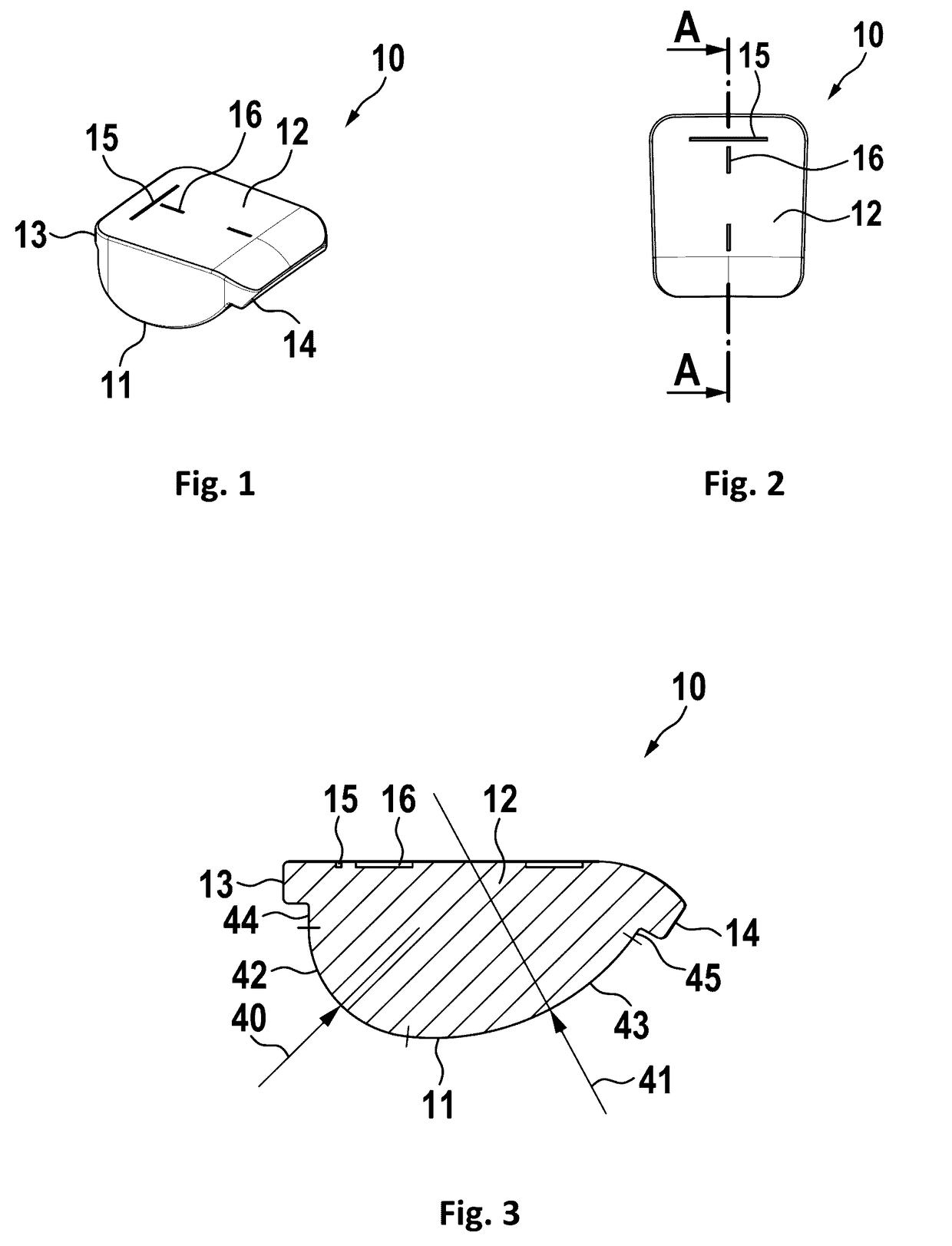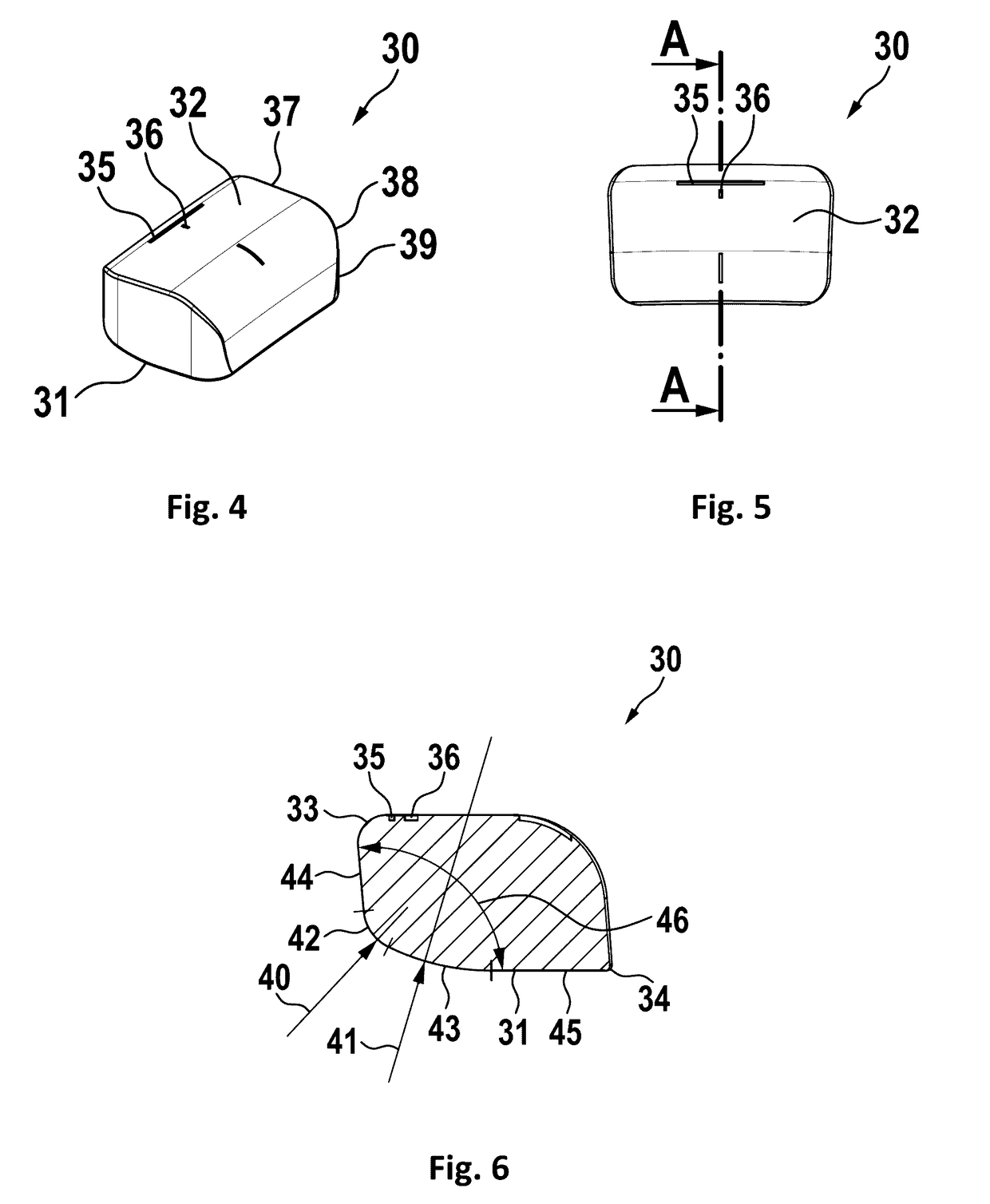Self-Adhesive Balancing Weight for a Vehicle Wheel
- Summary
- Abstract
- Description
- Claims
- Application Information
AI Technical Summary
Benefits of technology
Problems solved by technology
Method used
Image
Examples
first embodiment
[0064]In FIG. 1, a first embodiment, preferably for steel rims is shown. A balancing weight 10 has a top surface 12 and a bottom surface 11 opposing to the top surface. The top surface may bear at least one marking and / or an ornamental design. In this embodiment, there is a first line 15 which shows the orientation of the balancing weight and is approximately parallel to the circumference of the rim; a second line 16, which may be under a right angle and comprises of two dashes in this embodiment, is in a radial direction and points towards the axis of the wheel. The bottom surface 11 has a specific contour to be adapted to a large number of different rims, which will be explained later in detail. For holding the balancing weight for an easy assembly to the rim, the balancing weight may have a first extension 13 and / or a second extension 14.
[0065]In FIG. 2, the first embodiment is shown in a top view. Here a sectional cut A-A is indicated, which will be shown in detail in the next f...
second embodiment
[0067]In FIG. 4, a second embodiment is shown which is preferably suited for aluminum rims. As known from the prior art, balancing weights previously could have been attached only to comparatively planar surfaces of aluminum rims. A balancing weight 30 according to this embodiment now may be attached to the outer edge of an aluminum rim, which significantly increases the flexibility and the possible range of application of balancing weights. Again, this balancing weight has a top surface 32 and a bottom surface 31. Again, there may be markings on the top surface, as described before. There may be a first line 35 approximately parallel to the circumference of the rim, and a second line 36 in radial direction, which may be directed toward the axis of the wheel. In this embodiment it is preferred, if the top surface is curved and preferably comprises of a first planar top surface section 37, a curved top surface section 38, and a second planar top surface section 39. It is preferred, i...
third embodiment
[0081]FIG. 18 shows a balancing weight 70 of a third embodiment, preferably for aluminum rims, with a connecting means in a sectional view. Here, the second radius is extremely large or it is even missing, so that there is no second curved section, resulting in a plane bottom surface. Preferably the balancing weight 30 has a cut-out or recess 48 for holding the connecting means 60.
[0082]FIG. 19 shows a connecting means 60. The connecting means 60 may have at least one projection 61 interfacing with a cavity 49 in a balancing weight to improve anchoring of the connecting means within the balancing weight.
[0083]FIG. 20 shows a chain of balancing weights from the bottom side. Here, preferably, gaps or cutouts 18 are provided in the self-adhesive tape, which allow easier bending to adapt to a radius of a rim.
[0084]FIG. 21 shows a preferred embodiment of a self-adhesive tape 17. Here, gaps or cutouts 18 are provided, which allow easier bending to adapt to a radius of a rim.
[0085]FIG. 22 ...
PUM
 Login to View More
Login to View More Abstract
Description
Claims
Application Information
 Login to View More
Login to View More - R&D
- Intellectual Property
- Life Sciences
- Materials
- Tech Scout
- Unparalleled Data Quality
- Higher Quality Content
- 60% Fewer Hallucinations
Browse by: Latest US Patents, China's latest patents, Technical Efficacy Thesaurus, Application Domain, Technology Topic, Popular Technical Reports.
© 2025 PatSnap. All rights reserved.Legal|Privacy policy|Modern Slavery Act Transparency Statement|Sitemap|About US| Contact US: help@patsnap.com



